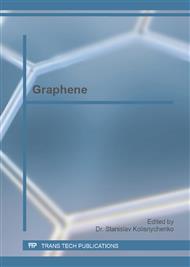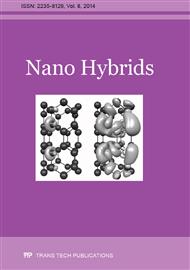[1]
T. Durkop, S.A. Getty, E. Cobas, M.S. Fuhrer, Extraordinary Mobility in Semiconducting Carbon Nanotubes, Nano Lett. 4 (2004) 35-39.
DOI: 10.1021/nl034841q
Google Scholar
[2]
M.A. Osman, D. Srivastava, Temperature Dependence of Thermal Conductivity of Single Wall Carbon Nanotubes, Nanotechnology 12 (2001) 21-24.
Google Scholar
[3]
N.E. Gorji, Quantitative analysis of the optical losses in CZTS thin-film semiconductors, IEEE Trans. Nanotechnol. 13 (4) (2014) 743-748.
DOI: 10.1109/tnano.2014.2318057
Google Scholar
[4]
B. Shan, K. Cho, Ab initio study of Schottky barriers at metal-nanotube contacts, Phys. Rev. B: Condens. Matter 23 (2004) 233405-233408.
DOI: 10.1103/physrevb.70.233405
Google Scholar
[5]
N.E. Gorji, Mohammad Houshmand, Carbon nanotubes application as buffer layer in Cu(In, Ga)Se2 based thin film solar cells, Physica E 50 (2013) 122-125.
DOI: 10.1016/j.physe.2013.03.001
Google Scholar
[6]
B.J. Landi, R.P. Raffaelle, S.L. Castro, S.G. Bailey, Single wall carbon nanotube–polymer solar cells, Prog. Photovoltaics Res. Appl. 13 (2) (2005) 165-172.
DOI: 10.1002/pip.604
Google Scholar
[7]
S. Bhattacharyya, E. Kymakis, G.J. Amaratunga, Photovoltaic Properties of Dye Functionalized Single-Wall Carbon Nanotube/Conjugated Polymer Devices, Chemical Materials 16 (2004) 4819-4823.
DOI: 10.1021/cm0496063
Google Scholar
[8]
P. Chen, X. Wu, X. Sun, J. Lin, W. Ji, K.L. Tan, Electronic Structure and Optical Limiting Behavior of Carbon Nanotubes, Phys. Review Lett. 82 (1999) 2548-2551.
DOI: 10.1103/physrevlett.82.2548
Google Scholar
[9]
S. Gunes, H. Neugebauer, N.S. Sariciftci, Hybrid solar cells based on dye-sensitized nanoporousTiO2 electrodes and conjugated polymers as hole transport materials, Chem. Rev. 107 (2007) 1324-1338.
DOI: 10.1021/cr050149z
Google Scholar
[10]
G. Xosrovashvili, N.E. Gorji, Numerical simulation of carbon nanotubes/GaAs hybrid PV devices with AMPS-1D, Int. J. Photoenergy (2014) 784857-788561.
DOI: 10.1155/2014/784857
Google Scholar
[11]
N.E. Gorji, Modelling the impedance of thin film PV in SCLC dominant region, Physica B 431 (2013) 44-48.
DOI: 10.1016/j.physb.2013.08.018
Google Scholar
[12]
H. Houshmand, M.H. Zandi, N.E. Gorji, Modeling the impedance of nanostructured PV in simulink/matlab, Mod. Phys. Lett. B 27 (20) (2013) 1350139-1350141.
DOI: 10.1142/s021798491350139x
Google Scholar
[13]
A. Mebadi, H. Houshmand, M.H. Zandi, N.E. Gorji, Simulations of the intermediate bandwidth fluctuations in nanostructured PV, Physica E 53 (2013) 130-136.
DOI: 10.1016/j.physe.2013.04.024
Google Scholar
[14]
T.S. Te Velde, Mathematical analysis of a heterojunction, applied to the copper sulphide-cadmium sulphide solar cell, Solid-State Electron. 16 (1973) 1305-1314.
DOI: 10.1016/0038-1101(73)90043-9
Google Scholar
[15]
Wei J, Jia Y, Shu Q, Gu Z, Wang K, Zhuang D, Wang Z, Luo J, Cao A, D. Wu, Double-walled carbon nanotube solar cells, Nano Lett. 8 (2007) 2317-2321.
DOI: 10.1021/nl070961c
Google Scholar
[16]
W.A. Anderson, R.A. Milano, I-V characteristics for silicon Schottky solar cells, in: Proceeding of IEEE, 63 (1975) 206-208.
DOI: 10.1109/proc.1975.9727
Google Scholar
[17]
S. Fonash, General formulation of the current-voltage characteristic of a pn heterojunction solar cell, Appl. Phys. 51 (1980) 2115-2118.
DOI: 10.1063/1.327883
Google Scholar
[18]
S.M. Sze, Physics of Semiconductor Devices, (2nd edition), New York, John Wiley & Sons (1981).
Google Scholar
[19]
M. Houshmand, M.H. Zandi, S.S. Dehkordi, M.D. Perez, N.E. Gorji, An equivalent circuit model proposed for the intermediate band nanostructured quantum dot solar cells, Modern Phys. Lett. B 26 (2012) 1250133-1250142.
DOI: 10.1142/s0217984912501333
Google Scholar
[20]
A.B. Phillips, R.R. Khanal, P.J. Roland, Victor V. Plotnikov, et al., Wiring-up Carbon Single Wall Nanotubes to Polycrystalline Inorganic Semiconductor Thin Films: Low-Barrier, Copper-Free Back Contact to CdTe Solar Cells, Nano Lett. 13 (2013).
DOI: 10.1021/nl402659c
Google Scholar



